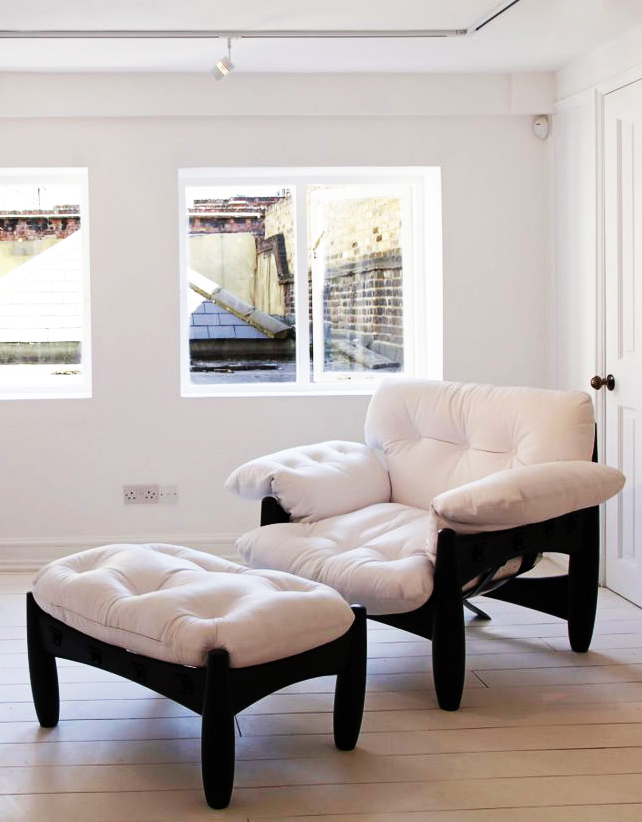
October 28, 2018Long known as a hotbed of mid-century modern furniture, Brazil is passing the aesthetic mantle on to a new crop of contemporary designers and dealers. Above, a master craftsman plies his trade in the workshop of the São Paulo gallery Apartamento 61. Top: In the gallery’s homelike setting are displayed, from left, a two-tone sofa by Acácio Gil Borsoi, a pair of Lina Bo Bardi chairs and a slatted bench also by Borsoi. Photos by André Klotz
The popularity of Brazilian mid-century design has made household names of Sérgio Rodrigues, Joaquim Tenreiro, Jorge Zalszupin and other greats. Their particular brand of modernism is characterized by an émigré point of view (they were Lithuanian, German, Polish, Ukrainian, Portuguese, Italian), a preference for highly figured indigenous Brazilian woods, a reverence for nature as an inspiration and an atelier or small-production mentality.
Today, a new generation of Brazilian designers is both continuing their predecessors’ legacy and expanding it, harnessing cutting-edge technologies for their creative process, infusing objects with a more enlightened ecological consciousness and running multidisciplinary studios that create everything from furniture to lighting to flatware. Here, we visit a handful of galleries and makers representing the range of Brazilian design from the mid-20th century through today.

Left: From their São Paulo gallery, ETEL, mother and daughter Etel (left) and Lissa Carmona sell an array of modernist and contemporary Brazilian furniture. Right: The modern classics they have on hand include Jorge Zalszupin‘s Romana and Pétalas coffee tables and Brasiliana sofa. All ETEL photos by André Klotz
ETEL, the São Paulo gallery that almost single-handedly resuscitated interest in Brazilian modernist furniture, is located in a mid-20th-century home designed by Oswaldo Bratke in the Jardim Paulistano district. “We are guardians of Brazilian design as a whole category of design,” says Lissa Carmona, the 46-year-old daughter of company founder, Etel Carmona, as she perches on an elegant Jorge Zalszupin sofa. This is not an idle boast. ETEL, which operates a workshop as well as a gallery, indeed represents a continuum that originated in the mid-20th century.
The elder Carmona, herself a designer and still very active in all aspects of the business, began in the early 1980s buying pieces for her personal collection by designers who are recognized masters today but who were then mostly forgotten. She eventually found that she wanted so much restoration done on the furniture that, within five years, she needed to staff an entire workshop. Today, preserved vintage treasures comprise one segment of ETEL’s business.

Left: A Wyllis cabinet by contemporary architect-designer Arthur de M. Casas. Right: A Giuseppe Scapinelli tea trolley
In the late 1980s and early ’90s, Etel began designing furniture and also producing and exhibiting the work of other Brazilian designers, such as Claudia Moreira Salles and José Bento. Her roster continued to grow into the early 2000s, coming to include architects Arthur de M. Casas and Isay Weinfeld, among other creative talents.
In the late 1990s, heirs of 11 partners connected to the mid-century furniture company Branco & Preto approached Etel about reproducing some of its original designs. Soon after, Zalszupin, who had closed his Brazilian studio and moved to Paris, did the same. Official reissues and new works by recognized living legends make up a second segment of ETEL’s business, which the Carmonas consider “contemporary” Brazilian design.

The gallery sells new re-editions of Oscar Niemeyer’s Marquesa bench, which he created in 1974 in collaboration with his daughter, Anna Maria.
The third component comprises work by designers who are just beginning to produce what the Carmonas think of as tomorrow’s classics. They include siblings Marcelo Alvarenga and Susana Bastos, of the Alva design studio, and architect-designers Osvaldo Tenório and Marcio Kogan, both soon to release capsule collections through ETEL.
“We are now a design company,” says the younger Carmona. “But we call ourselves haute couture, producing unique, limited-edition and very complex pieces. I’m not interested in large production. We are not for the mainstream. We are always playing the field between function and design art.”
Shop ETEL on 1stdibs

Left: Designer Andrea Macruz works at the intersection of the organic and the mechanical, often using state-of-the-art technology to create pieces based on natural forms (photo by Flávio Sampaio). Right: One such item is her c.as hanging lamp.
Andrea Macruz combines two of the characteristics of the classic Brazilian designers: an international lineage (Lebanese on her father’s side, Portuguese and indigenous Brazilian on her mother’s) and a reverence for nature. Both very much inform her work, but Macruz — who established her studio in 2010 after working with architects Marcio Kogan, in São Paulo, and Massimiliano Fuksas, in Paris — brings two new elements to her work. She uses both 3-D printing and CNC (computer numerical control) technology to create her unique pieces.
“Most inspiration for my work comes from nature itself,” says Macruz, “from a rain-forest leaf or a tree.” Her translations of these are hardly literal, however. The connection, in fact, is often barely discernible. That is because the forms are rooted in patterns found in nature that are manipulated with computer software. For example, one would never guess a set of four trivets simulate the shape of an electromagnetic field, or that a light fixture’s silhouette is based on jellyfish, or that a 3-D-printed vase is an abstracted representation of a Cerrado tree, characterized by contorted branches and thick bark and found on the Brazilian savannah. Yet, all begin in the natural world before morphing on a computer screen into the shapes of Macruz’s elegant objects.

The designer uses 3-D-printing to create her mus2 wall lamp, which recently won a bronze at Italy’s A’Design Award and Competition. Photo by Flávio Sampaio
At first glance, the connection between nature and the materials she uses is equally hard to discern. The vase, for instance, is clearly plastic; the light fixture, carbon steel; the trivets, Teflon. However, she says, “I try to work with different materials that are not harmful to the environment. A lot of Brazilian work is wood, but I’m not sure it’s sustainable.”
Her solution is to employ biodegradable plastics, paper, Bioglitter and natural pigments like saffron and indigo. She uses wood, too, as well as Brazilian granite and marble. But these are often sliced very thin and applied to a bioplastic matrix. This enables her both to reduce the amount of the stone or wood she needs and to create items, like benches, that appear heavy and solid but are actually light.

Macruz’s f.ly lamp — made of folded paper with a neutral pH to prevent yellowing, and colored with natural dyes — also received an A’Design award. Photo by Flávio Sampaio
The computer can enter her process either toward the beginning or at the end. She created an abstract design on an aluminum panel, for example, by first blowing pigments through a straw onto paper and then scanning the resulting pattern and printing it onto the metal. Other times, she generates a digital template for an object, like a bench, which she then produces by hand out of wood or some other material. In the latter case, she points out, “the CNC machine itself can create unexpected patterns and details.”
Shop Andrea Macruz on 1stdibs

Left: Designer Tiago Curioni assembles a prototype of his Aldeído chandelier, a piece inspired by organic chemistry (photo by Rosali Curioni). Right: Curioni’s limited-edition Sol que Sua vase combines brass and blown glass (photo by Henrique Uhlmann).
“We do not produce furniture,” proclaims Tiago Curioni. “We produce stories through our furniture.” And much of this young architect-designer’s work indeed displays narrative intention, as well as a desire to create sensory emotional experience. The way to ensure this, he feels, is to break from “excessive use of wood . . . and traditional construction systems.”
Wood is nevertheless present in Curioni’s work, as in his Hot Roll coffee table and Hashi light. Much of it, however, is upcycled: A chair produced with artist Andrey Zignatto, for example, incorporates old scaffolding boards, while the Hashi light’s wooden elements are construction-site detritus, and the Pallebox stool repurposes discarded pallets.
Curioni sees his pieces as definitely, if subtly, Brazilian. “It is a breath of Brazil in a product that can be marketed anywhere in the world,” he explains. “It is the combination of materials only found in Brazil, the use of color or authentic Brazilian manual craftsmanship, such as the Noemia rocking chair, made to honor my grandmother, who lived in a typical inland city where all the houses had these spaghetti-string chairs in the forties, fifties and sixties.”

Curioni’s minimalist steel-framed Velvet chair comes in nine colors. Photo by Eduardo Magalhães.
Where Curioni truly distinguishes himself is in his witty perceptual evocations. The Roof Lamp chandelier, for example, looks like an eco-conscious home’s peaked roof covered in faux moss, a chimney-like protrusion on one end serving as the socket into which you screw a light bulb, while the Savannah armchair resembles a bundle of tree limbs.
These pieces produce “a kind of pleasant aura around you,” he says. “It happens when I use elements that activate sensations in people — a material that has a touch different from what they are accustomed to, that smells very specific or even makes a noise when used: The Life Collection line has the scent of trees in a forest, and the Savannah armchair, when the user sits, shakes the tips of the branches, creating a noise of branches beating in the wind.”
Shop Tiago Curioni on 1stdibs

Husband-and-wife gallerists André Visockis and Vivian Lobato operate Apartamento 61 out of a mid-century residence designed by Rino Levi. They’ve filled the space with such pieces as a Joaquim Tenreiro folding screen, a Móveis Forzan side table, an Enrico Furio Dominici floor lamp and a Robin Day swivel lounge chair. All Apartamento 61 photos by André Klotz
“We’re the youngest to the vintage market,” says graphic designer André Visockis, referring to Apartamento 61, the São Paulo gallery he runs with his journalist wife, Vivian Lobato. The business’s name derives from the unit number of the couple’s former abode, which they furnished entirely with mid-20th-century Brazilian furniture before deciding to turn their collecting hobby into a business. They now live in the gallery, located in a 1939 residence designed by architect Rino Levi.
Visockis and Lobato started Apartamento 61 online in 2014 and moved to their current location, in the Pinheiros neighborhood, just two years ago. Yet, they are wise beyond the youth of their business. “Nobody’s going to live off vintage,” admits Visockis, taking a drag from his hand-rolled cigarette. “It’s getting more and more expensive and rare.”

A Lina Bo Bardi Tripé chair, a Giuseppe Scapinelli floor lamp, a free-form coffee table in the manner of Jean Royère and a butterfly chaise sit in front of a fireplace in the couple’s gallery.
Their Plan B? “We are trying to find new things, not just the same five big names.” Although they carry exquisite furniture by Lina Bo Bardi, Carlo Hauner, Giuseppe Scapinelli and other usual suspects, they travel farther afield, unearthing the work of such virtually unknown Brazilian architects and designers as Acácio Gil Borsoi, who worked mostly in the country’s northeastern provinces in the 1950s through the ’60s. “We’re idealists in a sense,” Visockis says. “We dive into research every time we do a show.”
Like the Carmonas, they recognize the need for new blood. The self-taught Bianca Barbato, a 39-year-old paulistana whose preferred medium is cut, folded and perforated metal (she also works in resin), is in this category, as is the 43-year-old, Rio de Janeiro–based woodworker Ricardo Graham Ferreira. Barbato’s polished surfaces and geometric forms contrast interestingly with Apartamento 61’s vintage inventory, while Ferreira’s sensibility seems of a piece with it, although with a present-day twist. “We have to embrace contemporary designers,” Visockis emphasizes. “It’s our duty as young people.”
Shop Apartamento 61 on 1stdibs

Left: Designer Noemi Saga combines inspiration from mid-century Brazilian masters with Japanese techniques (portrait by Tomas Arthuzzi). Right: Her Hermit lamp, handcrafted from solid Brazilian wood, can be easily carried anywhere more light is needed, thanks to its ingeniously built-in handle (photo by Marcus Cimardi).
“We need objects we can have an emotional connection to,” says designer Noemi Saga. “I’m very interested in the relationship between objects and people. I want them to interact with my pieces.” She cites her lantern-like Hermit lamp as an example. “People can carry it from room to room, put it on a table or hang it on a wall.”
Saga draws inspiration from mid-century Brazilian greats, whose influence may be seen in her predilection for exotic Brazilian woods. “We have so many beautiful varieties,” she says over wine and smoked salmon at São Paulo’s chic new hotel and watering hole, Palacio Tangará, nestled in the lush park named for architect and designer Roberto Burle Marx.

Saga’s sculptural and multifunctional INI daybed can serve as a bench, sofa or bed. It was inspired by hammocks made and used by indigenous peoples. Photo by Marcus Cimardi
She rattles off some of her favorites: “Caixeta, jequitiba, cedro, muirapiranga.” But to these Brazilian woods, she brings a Japanese sensibility, which manifests in forms like the Hermit as well as in certain techniques. Among the latter is shou sugi ban, a method of preserving wood by charring it that has been used in Japan for centuries. Saga employs it in her Nuno sconce and pendant and in her Bamboula lamps, developed for Cristiana Bertolucci Estúdio, a well-known local lighting gallery.
Saga also works with industrially produced materials, marble and upholstery. Examples include her Thé coffee table, Café side table and Madeleine line of seating, along with the colorful Conogó room screen, made of painted MDF (medium-density fiberboard) and dually inspired by ancient tribal forms and kinetic art.

The designer crafts her Café side tables in marble, as shown here, as well as in solid Brazilian wood. Photo by Tomas Arthuzzi
Like the Brazilian mid-century masters, she can use her wood workmanship to turn a quotidian piece like a bicycle stand (her Parô Retro) into a thing of sensual beauty. And as with Curioni, an occasional tongue-in-cheek reference can bring lightness and fun to otherwise seriously crafted pieces. Exhibit A: the adorably named Girafa, a combination step stool and clothes hanger.
Shop Noemi Saga on 1stdibs

Left: In addition to designing for several brands, Guilherme Wentz creates pieces that put a Brazilian spin on a Scandi-modern aesthetic (portrait by Lorena Dini). Right: He originally made his Post-Tropical vase, now available in varnished sucupira wood and solid copper, for the São Paulo Museum of Modern Art.
As the purveyor and designer of the WENTZ collection (which he founded in partnership with entrepreneur Rafael Gehrke), the artistic director of Decameron (a Brazilian furniture brand with a stable of young talents) and a sought-after independent creator for such other Brazilian companies as Nos and Artefacto, 30-year-old Guilherme Wentz represents a link between low-tech, handmade, atelier-minded design and industry.
Some pieces, such as his Eve and Tela chairs, hew closely to the aesthetic of his forebears, reinterpreting Scandinavian modern lines through a Brazilian cultural lens and incorporating jequitiba and other indigenous hardwoods, as well as traditional turning and joinery. Others rely heavily on software — particularly to determine scale and develop details — and industrial manufacturing processes. Having worked at Brazilian tableware company Riva, Wentz says, “It feels right to think about the partners’ production capabilities as I design, rather than trying to do everything with my own hands.”

Left: The Tela lounge chair reimagines the caning of mid-century furniture on a larger scale, using cotton thread instead of rattan. Right: The Vidro tables, available in two heights, play with the contrast between solid varnished hardwood and smoky translucent glass.
No matter who he is designing for, however, Wentz favors a minimalist approach, often distilling his pieces down to a single gesture, as in a series of vases, each of which is little more than one unbroken line of copper or steel tube just large enough to hold a lone leaf or flower.” Wentz’s Rope light could not be more spare or essential: a frosted glass sphere suspended from the ceiling in an aluminum noose.
“Simplicity is definitely what I value the most,” Wentz says. “Ten years ago, I realized I could live my life more simply and closer to nature. It may sound clichéd, but when we started my independent brand, WENTZ, we wanted this simple lifestyle to be at the core of our core. It’s a reaction to the way we live, the way we consume. We want the products we make to inspire the people who use them. I want them to associate our products with a silent, calm peace.”


